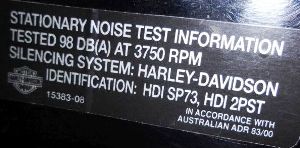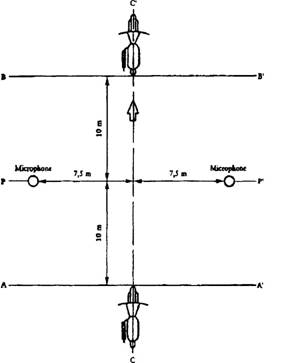 |
The Motorcycle Riders' Association of South Australia |
|
||
|
|
 |
| Motorcycle Noise Emissions - Summary | ||||||||||||||||||||||||||||||||||||||||||||||||||
| Vehicle noise standards define limits on external noise generated by all light and heavy vehicles, motorcycles and mopeds in order to limit the contribution of motor traffic to community noise. The age and engine capacity of your vehicle will determine the allowable noise your vehicle can make. We recommend that you know your rights, and have a basic understanding of the regulations. | ||||||||||||||||||||||||||||||||||||||||||||||||||
| Units of Noise Measurement - dBA | ||||||||||||||||||||||||||||||||||||||||||||||||||
| A-weighted decibels, abbreviated dBA, or dBa, or dB(a), are an expression of the relative loudness of sounds in air as perceived by the human ear. In the A-weighted system, the decibel values of sounds at low frequencies are reduced, compared with unweighted decibels, in which no correction is made for audio frequency. This correction is made because the human ear is less sensitive at low audio frequencies, especially below 1000 Hz, than at high audio frequencies. | ||||||||||||||||||||||||||||||||||||||||||||||||||
| Australian Design Rules (ADR) | ||||||||||||||||||||||||||||||||||||||||||||||||||
|
The Australian Design Rules (ADRs) are national standards for vehicle safety, anti-theft and emissions.
The ADRs are generally performance based and cover issues such as occupant protection, structures, lighting,
noise, engine exhaust emissions, braking and a range of miscellaneous items. ADRs are generally not easy
to follow and are technically written making them very uninteresting for the casual reader.
This page attempts to summarise the key details to make it easier for the general public to follow. Before a new motorcycle can be offered for sale in Australia, it must meet and receive certified compliance with the current Australian Design Rule for noise emissions. Once it is registered, it immediately becomes bound by the 'in-service' Vehicle Standards relevant to the State or Territory in which it is registered. Generally, the In-Service regulations follow the ADR. | ||||||||||||||||||||||||||||||||||||||||||||||||||
| ||||||||||||||||||||||||||||||||||||||||||||||||||
|
You will note the steady reduction in 'drive-by' noise emissions through successive ADRs.
The latest stationary noise level shows '+5 dBA over the label signature'.
This means that if your label says 98dBA then you would be given an allowance for
vehicle 'wear and tear', resulting in 98+5 = 103dBA before any enforcement notice can be issued. ADR83/00 makes reference to two noise levels, one from a moving vehicle (drive-by) and one from a stationary position. The ADR contains specific details on the setup required for recording the noise level in both scenarios. This represents the TOTAL noise coming from the vehicle and includes all sorts of noise sources like the engine, whether it's air-cooled or water-jacketed, intake tract, driveline, tyres, sound absorbing fairings, etc. Stationary Noise emission is all about noise from the muffler. A test of stationary noise is a measure of muffler performance. Stationary noise can be easily tested, while drive-by noise is very difficult to measure except under very specific controlled conditions. | ||||||||||||||||||||||||||||||||||||||||||||||||||
| AVSR - Australian Vehicle Standards Rules | ||||||||||||||||||||||||||||||||||||||||||||||||||
|
Prior to the ADRs, motorbikes did not have compliance plates and need to meet the Australian
Vehicle Standards Rules, and in each State follow the National model AVSRs published by the
National Transport Commission (NTC). These establish 'in-service' requirements for all sorts of things,
including emitted noise levels - but from the muffler only, i.e. a measure of muffler performance.
Hence, in each State, the VSRs 'should' reflect the year cut-offs for noise limits as in parallel
with the mandatory ADR compliance. The NTC define the allowable noise emission limits for vehicles in Division 3 starting at page 113 of their AVSR 1999 document (link below). In summary, motorbikes too old to fit the above ADR table will have a limit of 100dBA. AVSR 2006 from the NTC. AVSR 1999 from MRASA website. AVSR 2006 from MRASA website. | ||||||||||||||||||||||||||||||||||||||||||||||||||
| South Australian Vehicle Noise Regulations | ||||||||||||||||||||||||||||||||||||||||||||||||||
|
Most states manage noise through environmental regulations as well. The South Australian legislation on
road traffic light vehicle standards (link below) make reference to the ADRs. Clause 12 has an exemption from the VSRs through compliance with the ADR. This states, A requirement of Part 5 to Part 13 of the Light Vehicle Standards does not apply to a vehicle or combination if
Clause 139 refers to the silencing device for exhaust systems Clause 140 refers to the allowable noise for a motor bike or trike being
| ||||||||||||||||||||||||||||||||||||||||||||||||||
| Compliance Plate or Information Label | ||||||||||||||||||||||||||||||||||||||||||||||||||
|
Find your compliance plate and check the details on the information label, which can be
located anywhere on a motorbike. It is not a legal requirement to
have it on the frame, except for brand new bikes at initial registration. An example is shown below.
This will define the allowable noise (in dBA) at a specific engine rpm, and the muffler system fitted
to your vehicle (also stamped onto your exhaust). The rpm on the label is defined as 'half ESMP' - as detailed in the test procedure manual. ESMP is the Engine Speed at Maximum Power, at which the noise emission test should be conducted. | ||||||||||||||||||||||||||||||||||||||||||||||||||
 Example Information Label | ||||||||||||||||||||||||||||||||||||||||||||||||||
| ADR Noise Testing Conditions | ||||||||||||||||||||||||||||||||||||||||||||||||||
|
The ADR contains significant information outlining the testing requirements, clarifying what
is deemed a fair test environment. Some items include the ground surface condition, nearby objects, other
ambient noise and wind effects, proximity of the microphone to a kerb. During the measurements the
gearbox shall be in neutral gear. If it is impossible to disconnect the transmission, the driving wheel
of the motorcycle shall be allowed to rotate freely, for example by placing the vehicle on its centre stand.
The test DOES include ambient noises to be recorded, including engine cooling fans, chain or other mechanical
noises. Advances in design have resulted in very quiet engines and drivelines, allowing a greater proportion of allowable 'drive-by' noise to come from the exhaust alone. Hence many ADR 83/00 machines are permitted 'louder' exhausts. When obtaining ADR compliance, after passing the drive-by noise test, the vehicle is parked and the 'signature' noise level of the muffler is recorded as the maximum permissible muffler noise emission for that particular vehicle. Any aftermarket muffler must meet the same limit. For the stationary test, one operator attends to the microphones and measuring devices, another will bring the vehicle to the required revs then slams the throttle shut. This is repeated three times and the highest rounded up reading is used. The setup of the test site has specific dimensions as shown in the following diagrams, which have been sourced from the online ADR. If you want further detail, please read the full ADR (link below). | ||||||||||||||||||||||||||||||||||||||||||||||||||
 Test for stationary motorcycle  Test for motorcycle in motion | ||||||||||||||||||||||||||||||||||||||||||||||||||
| Reference Material and Websites | ||||||||||||||||||||||||||||||||||||||||||||||||||
|
The MRASA would like to recognise the following sources and contributors of information
on the subject of vehicle noise emissions. Guy Stanford, Australian Motorcycle Council (AMC) Australian Government website - Vehicle Noise. Australian Government ADR 83/00. Road Traffic (Light Vehicle Standards) Rules 2018 of South Australia - Webpage with links to PDF's from 2018 (current and historical) National Transport Commission - NTC Home Page. | ||||||||||||||||||||||||||||||||||||||||||||||||||
|
| ||||||||||||||||||||||||||||||||||||||||||||||||||
|